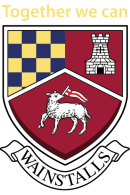Wainstalls School PTA is registered with the Charity Commission for England & Wales under Charity Number 1193474. To complete our charity registration, we adopted the Parentkind model constitution on 2nd November 2020. A constitution is a crucial governing document that outlines the fundamental rules and procedures our committee members must follow in managing the PTA. Part of this constitution defines our charitable objectives, which reflect our purpose as a PTA and guide our actions.
Our charitable objectives commit us to advance the education of pupils in the school in particular by:
- Developing effective relationships between the staff, parents, and others associated with the school
- Engaging in activities or providing facilities or equipment that support the school and advance the education of the pupils.
Code of Conduct
A code of conduct provides clear guidelines on behaviour to ensure that members behave in a professional manner and that everyone is treated with respect. It sits alongside our PTA’s constitution and supports its charitable objectives. It should be followed by all members of our association, not just those on the committee.
Managing PTA Funds
Legally, it is both the right and responsibility of our elected committee members to determine whether an activity or spending decision aligns with our charitable objectives. However, consulting our members to gain their support is equally important. By acting responsibly in both fundraising and spending, our PTA builds trust and support within the entire school community, including members, school staff, and governors.
Who do PTA funds belong to?
The school and our PTA are separate entities, which means any funds raised by the PTA belong solely to the PTA. As a registered charity, charity law requires our elected committee members (our trustees) to decide how PTA funds are spent. The school cannot determine how PTA funds are allocated, and PTA funds shouldn’t be factored into the school’s budgeting process. Additionally, PTA funds do not need to be audited at the same time as school funds.
Can we save PTA funds for larger projects?
Funds raised by the PTA should be spent within a reasonable timeframe and in ways that benefit the pupils. However, if we commit to funding a large project, we may save PTA funds specifically for that purpose over a longer period while additional fundraising is conducted. Decisions to save funds for a large project should be recorded in the minutes of the relevant committee meeting. Keeping our members informed on fundraising progress and expected timelines for achieving our goals is essential for transparency and maintaining trust.
What are reserves and restricted funds?
- Reserves:
It’s important for the PTA to retain enough money to cover its operational costs. These funds are known as reserves, covering essential expenses such as PTA membership fees with Parentkind, purchasing goods for events, or paying third-party suppliers (e.g., a DJ for a school disco). The amount kept as reserves is decided by our elected committee members. - Restricted Funds:
When raising money for a specific, larger project (e.g., a school minibus or playground equipment), the PTA may accumulate funds over a longer period. Funds raised for a specific purpose are known as restricted, or “ring-fenced,” funds. One way to manage restricted funds is to set aside a percentage of funds raised, using the remainder for immediate benefits. At fundraising events, we aim to clearly communicate how the money raised will be allocated and what percentage, if any, will be retained for larger projects.
Who decides how PTA funds are spent?
The decision on how to allocate PTA funds rests with our elected committee members. However, the PTA collaborates closely with the school to ensure that funds are used in ways that best benefit the pupils.
What is the “Wish List” approach?
Our approach to spending PTA funds involves asking the school to create a list of suggested items or projects for consideration. Ideas from PTA committee members, general members, and even pupils are also encouraged and added to this wish list. Once compiled, the list is reviewed with the school to ensure that the selected items will be beneficial and enhance students’ educational experience.
How do we select items from the “Wish List”?
To decide which items or projects to fund, we ensure that they align with our PTA’s charitable objectives, as set out in our constitution. All proposed purchases are then discussed and agreed upon by the committee members.
Can the school insist on using PTA funds for specific purchases?
No, only our elected committee members have the authority to decide how PTA funds are spent. However, maintaining a positive relationship with the school is crucial to our PTA’s success. If we feel the school is trying to dictate how PTA funds are spent, we should look for a compromise. For example, our committee may decide to allocate a portion of the PTA funds to the school’s project while reserving the remainder for other PTA-supported items and activities. In certain cases, we may also consult the wider school community before making a final decision.
Do we need to ask members for input on spending?
While gathering input from our members is valuable for ensuring that PTA funds reflect the community’s needs and priorities, the final decision on spending rests with the elected committee members. Member feedback is typically sought during PTA meetings, providing insights and ideas that help guide the committee’s choices.
